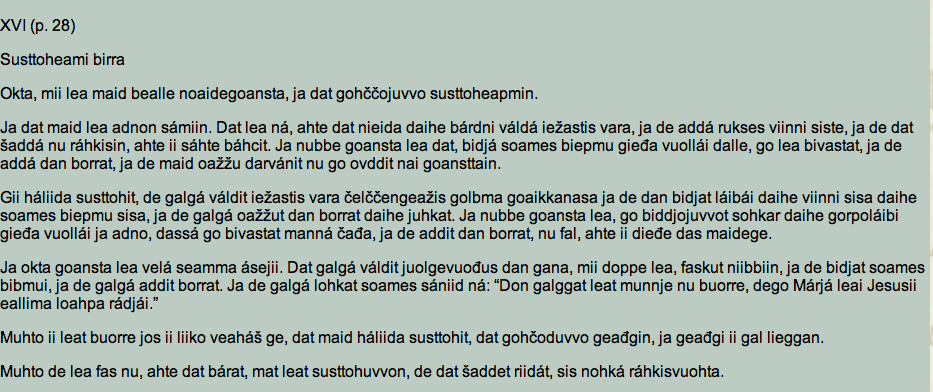Lappish Texts
"XVI. About love-awakening.
Something which is also half-witch-craft, and it is called love-awakening.
This the Lapps have used too. It is thus: the girl or the young man takes blood from himself and gives it in red wine [to the person whom he wants to inspire loves]; and then that person will be so enamoured that he cannot hold himself back. And another trick is to put something edible in the armpit when you sweat, and then give that to him or her to eat, then you can also get him or her to become attached to you, as with the foregoing trick.
He who wants to awaken [another person’s] love must take his own blood from the end of the little finger, three drops, and put them into bread or wine or other food; and then he must get [the person in question] to eat or drink it. – And another trick is [thus], that sugar or a biscuit is placed in the armpit and kept there until it is saturated with sweat, and the [you must] give that to the person to eat, without his knowing about it.
And there is still another trick for the same thing. With a knife you must scrape the scales off which are under the foot sole, and then put them into some food, and then give [the person] that to eat. And then you must read a few words, thus: “Thou shalt be as good to me as Mary was to Jesus until the end of life!” 21)
But it is not good if the person whose love you wish to awaken does not care the least bit for you; that person is then called a stone, and a stone cannot be heated [by passion].
But it is also true, that the married couples who are “love-awakened” will be quarrelsome, their love will cease.
21) Turi told me, that he had translated this incantation from Finnish."
Sámi deavsttat
XVI. (p. 28) Susttoheami birra.
Okta, mii lea maid bealle noaidegoansta, ja dat gohččojuvvo susttoheapmin.
Ja dat maid lea adnon sámiin. Dat lea ná, ahte dat nieida daihe bárdni váldá iežastis vara, ja de addá rukses viinni siste, ja de dat šaddá nu ráhkisin, ahte ii sáhte báhcit. Ja nubbe goansta lea dat, bidjá soames biepmu gieđa vuollái dalle, go lea bivastat, ja de addá dan borrat, ja de maid oažžu darvánit nu go ovddit nai goansttain.
Gii háliida susttohit, de galgá váldit iežastis vara čelččengeažis golbma goaikkanasa ja de dan bidjat láibái daihe viinni sisa daihe soames biepmu sisa, ja de galgá oažžut dan borrat daihe juhkat. Ja nubbe goansta lea, go biddjojuvvot sohkar daihe gorpoláibi gieđa vuollái ja adno, dassá go bivastat manná čađa, ja de addit dan borrat, nu fal, ahte ii dieđe das maidege.
Ja okta goansta lea velá seamma ásejii. Dat galgá váldit juolgevuođus dan gana, mii doppe lea, faskut niibbiin, ja de bidjat soames bibmui, ja de galgá addit borrat. Ja de galgá lohkat soames sániid ná: “Don galggat leat munnje nu buorre, dego Márjá leai Jesusii eallima loahpa rádjái.”
Muhto ii leat buorre jos ii liiko veaháš ge, dat maid háliida susttohit, dat gohčoduvvo geađgin, ja geađgi ii gal lieggan.
Muhto de lea fas nu, ahte dat bárat, mat leat susttohuvvon, de dat šaddet riidát, sis nohká ráhkisvuohta.
Sami text screenshot

|